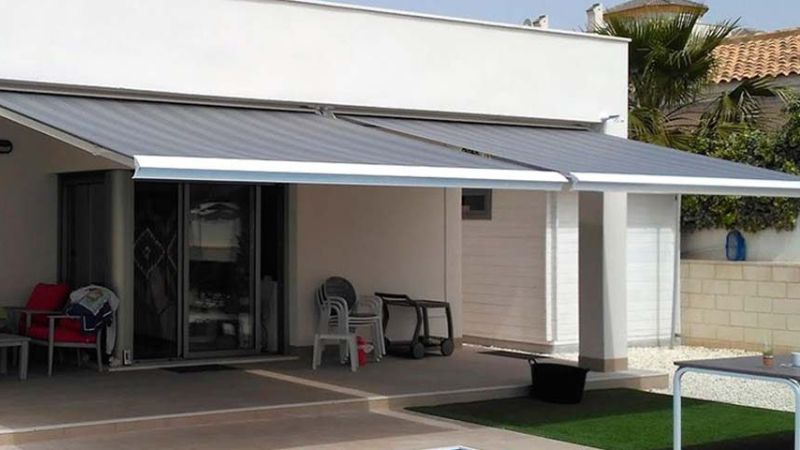As winter approaches, ensuring your awnings are prepared to withstand harsh weather is essential for their longevity. Cold temperatures, snow, ice, and wind can take a toll on your awning’s structure and fabric, leading to costly repairs or replacements. By taking a few preventive measures, you can shield your awnings from winter damage and extend their lifespan.
In this guide, we’ll share the top 9 tips to protect your awnings during the winter months, from regular cleaning to secure storage options. Following these simple steps will not only save you time and money but also help your awnings stay in excellent condition for years to come.
Top 9 Tips To Protect Your Awnings In Winter
1. Clean Your Awnings Before Winter Sets In
The first and most crucial step to protect your awnings in winter is to give them a thorough cleaning before the cold season begins. Dirt, debris, and organic matter like leaves can accumulate on your awning fabric, which can lead to mold or mildew if left untreated. Start by using a soft brush to sweep away loose debris. For more stubborn dirt, use a mild soap and water solution to gently scrub the fabric.
Be sure to rinse thoroughly and allow the awning to dry completely before storing or covering it. Moisture left on the surface can freeze during winter, causing the fabric to become brittle or even crack. Regular cleaning not only preserves the look of your awnings but also prepares them for winter storage or protection against the elements.
Also Read:- How To Clean Grease Stains From Awnings
2. Retract Your Awnings When Not in Use
If your awnings are retractable, make it a habit to retract them during the winter months when they’re not in use. Snow and ice accumulation can add significant weight, straining the fabric and hardware of the awnings. Over time, this added pressure can cause tears, sagging, or even structural damage.
Retracting your awnings when a snowstorm or freezing rain is expected will help avoid these risks. Modern retractable awnings often come with motorized options, making it easy to close them up quickly. If you don’t have retractable awnings, consider investing in a winter cover to protect them from direct exposure to winter weather.
3. Use Protective Covers
One of the easiest ways to shield your awnings from harsh winter elements is to use protective covers. These covers are designed specifically to protect awnings from snow, ice, and wind. Look for covers made from durable, waterproof material that fits snugly over your awning.
A well-fitted cover can prevent snow from accumulating on the fabric and stop ice from forming on the frame. In addition, a protective cover will block UV rays on sunny winter days, which can still cause wear and tear over time. Covers are a small investment compared to the cost of replacing or repairing your awnings due to winter damage.
4. Ensure Proper Drainage Around Awnings
Proper drainage around your awnings is critical during the winter. If water is allowed to accumulate around the base of your awnings, it can freeze, creating pressure on the supports and potentially causing cracks in the fabric. Make sure your gutters and downspouts are clear of debris and functioning properly to direct water away from the area surrounding your awnings.
If you notice pooling water near your awnings, consider installing additional drainage solutions, such as French drains or regrading the area, to prevent water buildup. By maintaining effective drainage, you reduce the risk of ice-related damage to both the awnings and their supporting structures.
5. Lubricate Moving Parts of Retractable Awnings
Retractable awnings have several moving parts that can become stiff or stuck in cold weather. To avoid this, regularly lubricate the moving parts with a silicone-based lubricant before the winter season begins. Pay special attention to the joints, arms, and cranks, ensuring smooth operation even in freezing temperatures.
Lubrication not only keeps the retractable mechanism working smoothly but also prevents rust and corrosion from developing due to exposure to moisture. Be cautious not to use oil-based lubricants, as they can gum up and cause more harm than good in cold weather. Regular maintenance of moving parts extends the life of your awnings and ensures they remain functional when needed.
6. Trim Nearby Trees and Branches
Overhanging branches can pose a serious risk to your awnings during winter. Heavy snow and ice can cause branches to snap, and if they fall onto your awnings, they can cause significant damage to the fabric and frame. To prevent this, inspect the trees around your property and trim any branches that hang over your awnings.
This simple precaution can save you from costly repairs or replacements. In addition to preventing physical damage, trimming trees also reduces the amount of debris like leaves and twigs that can accumulate on your awning, lessening the chance of mold and mildew buildup over the winter months.
7. Reinforce Awnings for Strong Winds
Winter storms often bring strong winds, which can put strain on your awnings, especially if they are large or extend far from your home. To prevent your awnings from being damaged or torn away by high winds, consider reinforcing them. Check the mounting brackets and hardware to ensure they are securely fastened.
If needed, use additional support brackets or ties to anchor the awning more securely to your home. If your awnings are not designed to withstand strong winds, consider retracting or removing them altogether during particularly stormy periods. Regularly inspecting and reinforcing your awnings will help them withstand winter’s worst weather.
8. Check for and Repair Any Damage
It’s a good idea to check your awnings for wear and tear before winter arrives. Small tears or frayed edges can become worse under the stress of snow, ice, and wind, leading to larger damage that’s more expensive to repair.
If you notice any issues, address them promptly by patching small holes or replacing worn hardware. In some cases, professional repair services may be necessary, especially if there is significant damage. By taking care of any needed repairs before winter, you’ll protect your awnings from further harm and avoid the inconvenience of trying to fix them in cold weather.
Also Read:- How To Protect Awnings From Sun Damage
9. Store Detachable Awnings Indoors
If your awnings are designed to be easily detached, consider removing them and storing them indoors during the winter months. This is especially useful for fabric awnings, which can suffer from prolonged exposure to snow, ice, and freezing temperatures.
To prevent the growth of mold or mildew, make sure they are totally clean and dry before storing them. Your awnings should be kept out of the direct sunlight and away from insects in a cool, dry location. You can prevent winter weather damage to your awnings and extend the life of your investment for many years to come by storing them indoors.
Conclusion
Taking proactive steps to protect your awnings from winter damage is a smart investment in their long-term durability. From cleaning and removing debris to using protective covers, these simple tips can safeguard your awnings from winter’s harsh conditions. By following these 9 tips, you can ensure your awnings remain in great shape for future seasons.
FAQs
Can I leave my awnings out in winter?
It’s best to retract or cover your awnings in winter to prevent damage from snow and ice buildup.
How do I clean my awnings before winter?
Use mild soap and water to remove dirt and debris, then let them dry completely to prevent mold growth.



